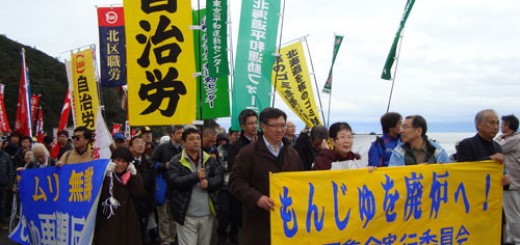Monju Restarted for the First Time in 14 Years Nuke Info Tokyo No. 136
On May 6, at 10:36 am, Japan’s Monju Prototype Fast Breeder Reactor (280 MWe) began test operations for the first time in 14 years. The reactor reached criticality precisely two days later on May 8 at 10:36 am. Japan Atomic Energy Agency (JAEA) plans to gradually raise Monju’s power output to 40% in 2011 and 100% in 2012. Full-fledged operations are scheduled to begin in the spring of 2013.
The day Monju was restarted, CNIC issued the statement on pages 2 and 3 of this issue of NIT. A couple of weeks earlier, on April 18, over 500 citizens from Fukui Prefecture and throughout Japan gathered on the beach in front of Monju to protest the proposed restart, but their voices were ignored.
Reflecting the fact that Monju and the nuclear fuel cycle program of which it is a key part are not just a Japanese problem, on May 21 a letter endorsed by 29 leading peace and environment groups from around the world was delivered to official delegates to the Nuclear Non-Proliferation Treaty Review Conference in New York. The letter urged delegates to:
1) Call upon the Government of Japan to abandon its fast-breeder and reprocessing program.
2) Support a Comprehensive Fissile Material Ban that includes civil plutonium programs.
Click here for the full text of the letter and a list of endorsing groups.
On April 26, immediately before Monju was restarted, there was yet another false alarm from a sodium leak detector. (See NIT 126 for information on previous occurrences.) But JAEA was determined to restart the reactor, and Fukui Governor Issei Nishikawa was not about to jeopardize the promises he had just received from the central government about “economic incentives” and extension of the Hokuriku Shinkansen (bullet train) Line to Fukui, so he gave his approval as scheduled on April 28.
Predictably, problems arose immediately after Monju was restarted. On the night of May 6 a radioactivity leakage detector malfunctioned. The problem recurred several times the following morning, but JAEA did not report the matter to the local authorities until about noon on May 7. The fact that the announcement of the first alarm sounding was delayed by half a day prompted Nobuaki Terasaka, director-general of the Nuclear and Industrial Safety Agency, to summon Japan Atomic Energy Agency President Toshio Okazaki and issue him a verbal warning.
Problems did not end there. On May 8 and 9 a temperature alarm for an auxiliary cooling pipe went off. Then on May 11 a worker failed to properly insert control rods. JAEA said the worker was inserting the rods for the first time and was unfamiliar with the procedure. The operation manual had no description of the procedure, nor was the worker trained to perform the insertion.
Be they sodium leak detectors, radiation leak detectors, or temperature monitors, malfunction of the sensors that indicate that something is amiss has become routine. JAEA acts on the assumption that they are all false alarms. One is reminded of the story of the boy who cried wolf. Who will believe when the alarm is for real?
JAEA claims that none of these problems affected safety, but we are waiting on tenterhooks to see what goes wrong next.
By Philip White (NIT Editor)

